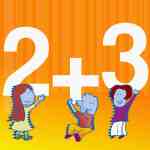Main Idea Versus Detail Trouble??

I hope everyone is having a wonderful start to 2013! I’d like to share a couple of ideas for talking to students about Main Idea versus Details. Have your students/children ever attempted to share a main idea by re-telling the entire story? As if every detail were just as essential as the detail before? Deena and I see this frequently with our students.
Two techniques come to mind that seemed to work for these particular students, so if they can help you to help one other child, that would be wonderful! One is a third grade student who is a Math Whiz and is really smart. I kept talking to him using “language terms” and I finally realized I might get farther with him if I spoke “his language.” I had him read a story that had five sentences. The story came from Visualizing-Verbalizing Stories Book 1 (If you are not familiar with Visualizing-Verbalizing, it is AMAZING–more information can be found at lindamood-bell.com.) I randomly assigned single digit numbers to each sentence and asked him to add the numbers up. Like this:
He wrote the numbers in a column, then added them up, quickly solved the problem, and provided me with the sum. I compared the paragraph to a math problem, that it is our job as readers to “figure out” the answer/main idea–that we cannot simply repeat the sentences. We wouldn’t simply repeat the numbers to be added. This really seemed to open his eyes to what we were trying to do. We still had quite a bit of work to do, and lots of practice working on this skill, but finally I had stopped explaining, “Main Idea” using words he was not understanding. We started talking about the “sum” of the story instead.
with the sum. I compared the paragraph to a math problem, that it is our job as readers to “figure out” the answer/main idea–that we cannot simply repeat the sentences. We wouldn’t simply repeat the numbers to be added. This really seemed to open his eyes to what we were trying to do. We still had quite a bit of work to do, and lots of practice working on this skill, but finally I had stopped explaining, “Main Idea” using words he was not understanding. We started talking about the “sum” of the story instead.
The second example is with an eighth grade girl who has significant difficulty, “Seeing the Trees for the Forest” (i.e., she gets the big ideas, but she’s not sure how the details fit in.) She is an artist, thinks in big ideas and loves all things visual. We were working on writing a summary of an article together. She was not “getting” the process. As it often happens with many of my ideas, it hit me at 2:00 in the morning that our job as “article-summarizers” (and really when we write any type of research paper) is to take someone else’ perfectly beautiful puzzle (an article, articles, books, etc.), pull out the pieces that carry the most meaning, leaving behind the puzzle-pieces that are not necessary to the scene. That is the index-card/note-taking portion of the process. Then, we re-arrange the puzzle pieces, adding our own “pieces” (language) to make a cohesive whole that is similar to the original, but has our artistic flair and our viewpoint as the authors.
 For the next session, I brought a 100 piece puzzle and had her physically extract the pieces she saw as being important. As we extracted important details from the article (not always an easy task,) we wrote them on index cards. I had my student tape a puzzle piece to each index card. I made sure that similar topics were attached to puzzle pieces from the same area of the puzzle so they would be grouped together in our summary in a way that matched the themes within the puzzle. Once we had our index cards/puzzle pieces written, we used post-it notes to connect the ideas into a cohesive paragraph using conjunctions and sequence words. If there is interest, I would be willing to duplicate this process so you have a visual–I wasn’t yet in the “digital age” when I was working with this student.
For the next session, I brought a 100 piece puzzle and had her physically extract the pieces she saw as being important. As we extracted important details from the article (not always an easy task,) we wrote them on index cards. I had my student tape a puzzle piece to each index card. I made sure that similar topics were attached to puzzle pieces from the same area of the puzzle so they would be grouped together in our summary in a way that matched the themes within the puzzle. Once we had our index cards/puzzle pieces written, we used post-it notes to connect the ideas into a cohesive paragraph using conjunctions and sequence words. If there is interest, I would be willing to duplicate this process so you have a visual–I wasn’t yet in the “digital age” when I was working with this student.
Hope these ideas might help someone else working with a student on main idea/details! Let us know.

